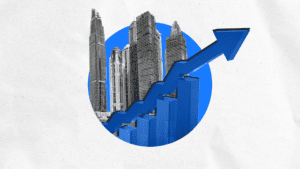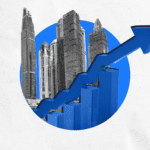As a real estate investor, timing the real estate cycle is essential. Real Estate regularly goes through multi-year cycles of boom and bust periods, just like any other long-running asset class or trend. Generally, real estate cycles can be closely tied to the economy. However, you can’t assume that the housing market would do well just because the economy is, or vice versa.
Real estate cycles are nuanced and there can be plenty of opportunities throughout the cycle to make successful investment decisions. For example, in Dubai, while real estate prices generally fell during the 2014-20 bear market, some areas like Dubai Marina/JBR performed better relative to the Dubai average.

What are the phases?
The real estate cycle is made up of four phases: recovery, expansion, hyper-supply, and recession. Understanding where the market is in the cycle is key to any investment decision you make as it will influence your buying strategy, the length of your holding period, and your exit strategy once you wish to realize your returns and capital gains. Moreover, real estate cycles can help predict the income and capital appreciation performance of an investment opportunity.
- Recovery
It can be tricky to identify the recovery phase of the cycle as most of the market will still be licking their portfolio wounds from the recession and will have a pessimistic outlook. Rental growth will remain stagnant, alongside dwindling upcoming supply. For investors, this is the ideal time to take advantage of below market value properties that have the potential to be special once the market recovers. You could wait out the rest of the recovery stage by adding value to these properties so that they’re ready to rent or sell outright as the economy shifts into the expansion phase. Timing is, obviously, key.
- Expansion
The economy is now starting to improve, job growth is getting stronger and there’s an increased demand for space and housing. The general public is now regaining confidence in the economy and the market, resulting in an increase in demand amongst renters and homebuyers. As the market is on an upswing, it’s the best time to invest in developing/re-developing your existing properties that meet the current market’s preferences and sell for more than the market value.
- Hyper-Supply
If you’ve been following the Dubai property markets for the past couple of years, you’d know market commentators and even some developers were ringing the alarm bells about this stage. During the expansion phase, investors and developers alike can end up flooding the market with supply to meet growing demand. Sentiment might be too optimistic, with a “build it and they will come” mentality, but that rarely happens as population demographics and black swan events don’t necessarily follow economic or real estate cycles. During this point, the market enters a tipping point where either there’s far too much excess supply or the economy shifts in a way in which demand pulls back. Dubai was hit with a double whammy during the 2014-20 bear market where there was an excess of supply and a combination of economic factors, like multi-year long falls in oil prices, and geopolitical issues affecting foreign investment, causing demand to pull back.
This is a great time to identify properties you feel confident will perform well in the next Expansion phase in the real estate cycle and follow a buy and hold strategy, so that you have exceptional stock ready when it comes time to sell again.
- Recession
The Recession stage is one that we’re all too familiar with for the past few years, until recently. Excess supply falls in FDI, low oil prices, and the first pandemic in a century derailed the Dubai property market to its most recent bottom in 2019-2020. During this stage, excess supply is far greater than demand by a wide margin, and property owners face high vacancy rates. Moreover, rental growth is non-existent, with landlords forced to reduce rental rates to attract renters who are also suffering from the economic downturn.
Timing this phase is crucial as it’s a fantastic opportunity to buy great properties at bargain prices and possibly even add value to them so that they’re ready for the next Recovery and Expansion cycles. But obviously, you don’t want to do it too early or you’ll be faced with extra costs to maintain the property/long periods of vacancy until the next boom phase comes, which can take time – depending on how bad the Recession stage is. Having a keen understanding of the real estate cycle – along with market/economic trends – can ensure that you purchase properties at Recession prices right before they begin to spike again as the market recovers.

How long do they last?
Well, it depends. In the US, which is a highly mature and developed market, the real estate market cycle can last up to 18 years on average. When it comes to the UAE, which isn’t as mature of a market yet and is still developing, the cycle can last around 7 years on average. This will obviously change over time and become longer as the UAE market develops, which is already happening at a rapid rate, relative to other real estate markets.
Generally, real estate cycles maintain their cyclical shape and continuously increase in value, with major breakdowns only happening in extenuating circumstances like large-scale natural disasters or wars. For example, following a full-scale war in a country, it’s unlikely the real estate market would recover – from both demand and supply perspectives – until years, if not decades after the conflict ends. Usually, real estate is one of the largest asset classes because it follows a positive trajectory in the long-term, with only major breakdowns like the example above would end that trend – but not forever, as the country rebuilds.
Conclusion
When looking at the UAE, despite the fall in real estate prices and its elongated Hyper-Supply and Recession stages until the end of 2020, thanks to excess supply and low oil prices, the UAE still maintained a positive price trajectory. For example, investors who would have invested in the Dubai Marina during the Recession stage in 2011 and held until 2014 (the last peak in the Dubai market), would have made 80.5% returns in capital appreciation alone. However, if they held the same Marina property till 2021, they’d have made 25% returns. Much of their returns until 2014 would have been canceled out had they bought and held, but they still ended up making some returns as the “new market bottom” is always appreciating.
The real estate cycle is a concept that every successful real estate investor must understand. All four phases of the cycle – recovery, expansion, hyper supply, and recession – cause the real estate market to dramatically shift, so investors must keep their hand on the pulse and eyes on the data to find opportunities in each stage of the cycle.
The UAE property market looks to be well into its recovery stage and may enter the expansion stage in the coming years, as overall value and transaction data are reaching record-highs, so it’s the perfect time to start investing in real estate to maximize your returns once the next Hyper Supply/Recession cycle eventually comes.
Fintechs like SmartCrowd make real estate investing easier and more affordable than ever. Gone are the days where you need to invest your life savings into a single property, you can now invest as low as AED 500 into multiple, fantastic property investment opportunities and build a strong, diversified portfolio. Timing the market to perfection is essential to your success as a real estate investor. You don’t want to be too early, or too late, but right on time!





